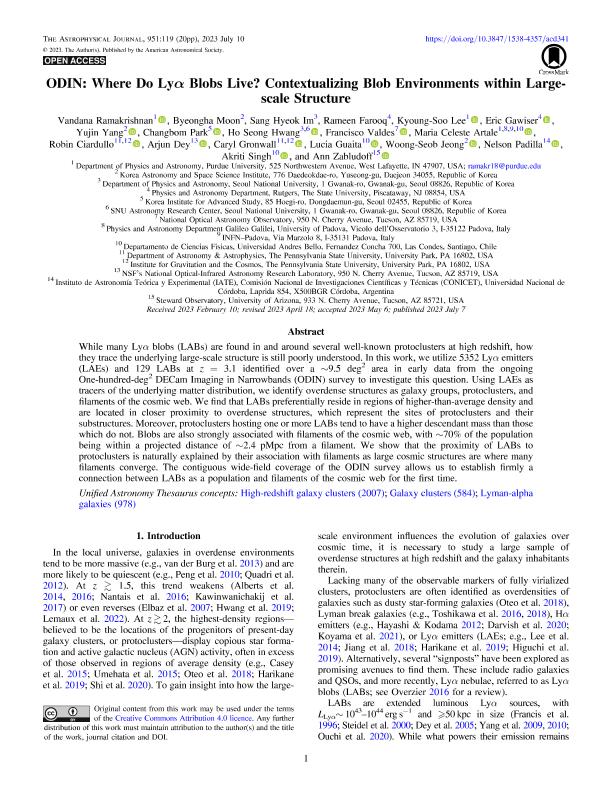Mostrar el registro sencillo del ítem
dc.contributor.author
Ramakrishnan, Vandana
dc.contributor.author
Moon, Byeongha
dc.contributor.author
Im, Sang Hyeok
dc.contributor.author
Farooq, Rameen
dc.contributor.author
Lee, Kyoung Soo
dc.contributor.author
Gawiser, Eric
dc.contributor.author
Yang, Yujin
dc.contributor.author
Park, Changbom
dc.contributor.author
Hwang, Ho Seong
dc.contributor.author
Valdes, Francisco
dc.contributor.author
Artale, Maria Celeste

dc.contributor.author
Ciardullo, Robin
dc.contributor.author
Dey, Arjun
dc.contributor.author
Gronwall, Caryl
dc.contributor.author
Guaita, Lucia
dc.contributor.author
Jeong, Woong Seob
dc.contributor.author
Padilla, Nelson David

dc.contributor.author
Singh, Akriti
dc.contributor.author
Zabludoff, Ann
dc.date.available
2024-03-27T09:56:28Z
dc.date.issued
2023-07
dc.identifier.citation
Ramakrishnan, Vandana; Moon, Byeongha; Im, Sang Hyeok; Farooq, Rameen; Lee, Kyoung Soo; et al.; ODIN: Where Do Lyα Blobs Live?: Contextualizing Blob Environments within Large-scale Structure; IOP Publishing; Astrophysical Journal; 951; 2; 7-2023; 1-20
dc.identifier.issn
0004-637X
dc.identifier.uri
http://hdl.handle.net/11336/231628
dc.description.abstract
While many Lyα blobs (LABs) are found in and around several well-known protoclusters at high redshift, how they trace the underlying large-scale structure is still poorly understood. In this work, we utilize 5352 Lyα emitters (LAEs) and 129 LABs at z = 3.1 identified over a ∼9.5 deg2 area in early data from the ongoing One-hundred-deg2 DECam Imaging in Narrowbands (ODIN) survey to investigate this question. Using LAEs as tracers of the underlying matter distribution, we identify overdense structures as galaxy groups, protoclusters, and filaments of the cosmic web. We find that LABs preferentially reside in regions of higher-than-average density and are located in closer proximity to overdense structures, which represent the sites of protoclusters and their substructures. Moreover, protoclusters hosting one or more LABs tend to have a higher descendant mass than those which do not. Blobs are also strongly associated with filaments of the cosmic web, with ∼70% of the population being within a projected distance of ∼2.4 pMpc from a filament. We show that the proximity of LABs to protoclusters is naturally explained by their association with filaments as large cosmic structures are where many filaments converge. The contiguous wide-field coverage of the ODIN survey allows us to establish firmly a connection between LABs as a population and filaments of the cosmic web for the first time.
dc.format
application/pdf
dc.language.iso
eng
dc.publisher
IOP Publishing

dc.rights
info:eu-repo/semantics/openAccess
dc.rights.uri
https://creativecommons.org/licenses/by-nc-sa/2.5/ar/
dc.subject
high-redshift galaxies
dc.subject
galaxy clusters
dc.subject
lyman-alpha galaxies
dc.subject.classification
Astronomía

dc.subject.classification
Ciencias Físicas

dc.subject.classification
CIENCIAS NATURALES Y EXACTAS

dc.title
ODIN: Where Do Lyα Blobs Live?: Contextualizing Blob Environments within Large-scale Structure
dc.type
info:eu-repo/semantics/article
dc.type
info:ar-repo/semantics/artículo
dc.type
info:eu-repo/semantics/publishedVersion
dc.date.updated
2024-02-08T10:19:16Z
dc.identifier.eissn
1538-4357
dc.journal.volume
951
dc.journal.number
2
dc.journal.pagination
1-20
dc.journal.pais
Reino Unido

dc.description.fil
Fil: Ramakrishnan, Vandana. Purdue University; Estados Unidos
dc.description.fil
Fil: Moon, Byeongha. Korea Astronomy And Space Science Institute; Corea del Norte
dc.description.fil
Fil: Im, Sang Hyeok. Seoul National University; Corea del Norte
dc.description.fil
Fil: Farooq, Rameen. Rutgers Universitynew Brunswick; Estados Unidos
dc.description.fil
Fil: Lee, Kyoung Soo. Purdue University; Estados Unidos
dc.description.fil
Fil: Gawiser, Eric. Rutgers Universitynew Brunswick; Estados Unidos
dc.description.fil
Fil: Yang, Yujin. Korea Astronomy And Space Science Institute; Corea del Norte
dc.description.fil
Fil: Park, Changbom. Korea Institute For Advanced Study; Corea del Norte
dc.description.fil
Fil: Hwang, Ho Seong. Seoul National University; Corea del Norte
dc.description.fil
Fil: Valdes, Francisco. National Optical Astronomy Observatory; Estados Unidos
dc.description.fil
Fil: Artale, Maria Celeste. Universidad Andrés Bello; Chile. Università di Padova; Italia. Consejo Nacional de Investigaciónes Científicas y Técnicas. Oficina de Coordinación Administrativa Ciudad Universitaria. Instituto de Astronomía y Física del Espacio. - Universidad de Buenos Aires. Facultad de Ciencias Exactas y Naturales. Instituto de Astronomía y Física del Espacio; Argentina. Purdue University; Estados Unidos
dc.description.fil
Fil: Ciardullo, Robin. University of Pennsylvania; Estados Unidos
dc.description.fil
Fil: Dey, Arjun. No especifíca;
dc.description.fil
Fil: Gronwall, Caryl. University of Pennsylvania; Estados Unidos
dc.description.fil
Fil: Guaita, Lucia. Universidad Andrés Bello; Chile
dc.description.fil
Fil: Jeong, Woong Seob. Korea Astronomy And Space Science Institute; Corea del Norte
dc.description.fil
Fil: Padilla, Nelson David. Consejo Nacional de Investigaciones Científicas y Técnicas. Centro Científico Tecnológico Conicet - Córdoba. Instituto de Astronomía Teórica y Experimental. Universidad Nacional de Córdoba. Observatorio Astronómico de Córdoba. Instituto de Astronomía Teórica y Experimental; Argentina
dc.description.fil
Fil: Singh, Akriti. Universidad Andrés Bello; Chile
dc.description.fil
Fil: Zabludoff, Ann. University of Arizona; Estados Unidos
dc.journal.title
Astrophysical Journal

dc.relation.alternativeid
info:eu-repo/semantics/altIdentifier/doi/http://dx.doi.org/10.3847/1538-4357/acd341
Archivos asociados
